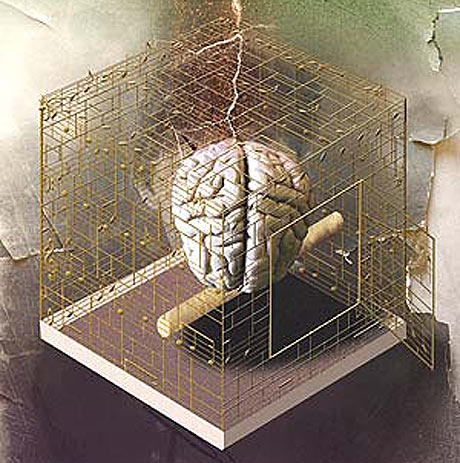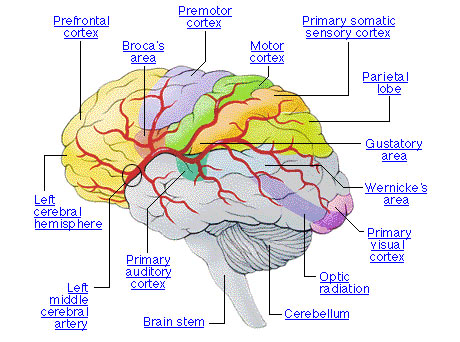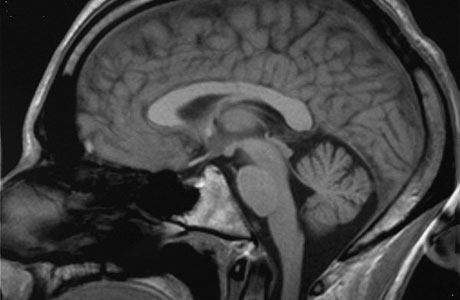The Musical Brain - A Brief Introduction
7-Aug-2009In the first of a new five part series, Chris Davies looks at the the musical brain...

Opening the door to the Musical Brain....
Picture courtesy of Simon Bosch
http://www.digital-illustration.com.au/fsetcont.html
As trained musicians who’ve spent years perfecting our art, we’re not used to thinking about exactly how we do what we do; we just do it.
We tend to take everything we do while we play for granted: reading the dots, pushing down the right valves, taking a breath here and there, and so on.
Billions
Yet every single thing we do while we play is supported by a vast and complex neural network, comprising billions of components throughout the brain and nervous system.
Although it may seem strange to try and think about our minds as the product of cells and tissue in our heads, much has been learned about music and the brain in recent years.
Complex research
In this article I’m going to explore a few fascinating facts about our musical brains, and try and make some of the more complex research that’s been carried out recently a little more reader-friendly.
The adult brain is a complex organ, made up of around 100,000,000,000 neurons . Neurons are tiny cells that operate in various components of the nervous system, and are charged with the responsibility of sending messages from our sensory organs (like our eyes and ears) to our brains for processing.
These ‘sensory’ neurons are not the only type of neuron that exists – there are also ‘motor’ neurons, which are responsible for our movement, and ‘interneurons’ that connect nearby neurons to each other.
The brain
The brain consists of four ‘lobes’ spread over two hemispheres (i.e. the right and left sides of the brain), and is constructed in layers. The outermost layer (the crinkly part that we usually see in pictures of the brain) is known as the ‘cortex’, which is Latin for ‘bark’ (the bark of a tree trunk is on the outside).

Now for the science bit... The brain and all its parts...
Goldfish
The cortex has evolved over millions of years to give us the facility of higher-thought, however most of the other animals on the planet are unable to hear music in the way that we do. Whereas we might hear 2 consecutive notes as related, a goldfish would probably hear them as 2 completely separate events with no connection .
Thankfully, modern science has moved on a little since the days of ‘phrenology’ (the study of bumps on the head), which attempted to find parts of the brain responsible for things like ‘cautiousness’ and ‘jealousy’.
Thanks to the most advanced kinds of scanning techniques (like MRI, fMRI, or PET), scientists have been able to figure out exactly which bits of the brain spring into action when we carry out different behaviours.
This has meant that it has become possible to determine which parts of the brain are responsible for the pushing down of valves, the reading of dots, and the differentiation between a crotchet and a hatchet.
Complex musicians
However, things are a little more complex for us musicians, as we shall see.
When we listen to, play, or even compose music, we draw on a number of skills that are not necessarily music-specific.
Primary
For example, we need the use of our eyes to read the music, and therefore call into play the primary visual cortex (or ‘V1’). This is located in the rearmost ‘lobe’ of the brain: the ‘occipital’ lobe, located at the back of the head. It is here that everything we see is processed.
Similarly, when we listen to music we call into the play the auditory cortices. These are divided into the primary and secondary auditory cortices, so-called because incoming signals from the ear go to the primary cortex before the secondary. These parts of the brain are located on what is known as the ‘temporal lobe’ (which is sort of just around your ears).
The primary auditory cortex (or ‘A1’) is responsible for the most basic processing of musical sounds, and plots all the notes we hear on what’s called a ‘tonotopic map’ (which basically means that sounds are ordered according to their frequencies – this enables us to tell a low sound from a high one).
Secondary
The secondary auditory cortex (or ‘A2’) is where the really complicated stuff goes on: there are loads of neural maps here that deal with relationships between the notes we hear. This is where simultaneous notes are processed into harmony, and consecutive notes are processed into some kind of melody.
Relationships between the various notes we hear are plotted, and as a result we can tell whether we’re playing the third of the chord or whether we’re playing a melody or not. As a result of the auditory cortices, the vibrations in air produced by musical instruments become music.
We also need to move when we play, and this calls on the primary motor cortex. Interestingly, movement, like many other bodily functions, is controlled ‘contralaterally’, which means that the left side of your brain is responsible for movements on the right side of your body.
So when you push down your first valve to play a B-flat, that action is actually being controlled by motor circuitry on the left side of your brain (i.e. in the left hemisphere). Movement is a little more difficult to pin down, since other areas, like the cerebellum (which means ‘little brain’ and controls balance) are also involved.
Not straight forward
As I said earlier, things are not quite as straight-forward for us musicians, since musical training and practice actually changes the way in which the brain develops, leading to some rather unusual results.
It is generally believed that for your bog-standard concert attendee, who may not play anything but appreciates a nice night of music, the right hemisphere of the brain is involved in processing melody.
However, for those of us who have received musical training over a long period of time, this processing tends to shift to the left hemisphere, which is normally considered the seat of language-processing.
This is not the only change that occurs as a result of musical training and practice. It has been proven that children who start learning to play the piano at an early age tend to have an enlarged ‘corpus callosum’ .
This is the bridge between the 2 sides of the brain, and it allows the two sides to communicate with one another and share the fruits of their labours. There have also been cases of enlarged cerebellums in pianists who started playing at an early age.

Looking inside the brain: The brain going about its work...
Motor programming
The cerebellum is very much involved in motor programming in the brain – the ability that we have to simply play a scale without having to think too much about it is due to the fact that the particular sequence of movements needed has been stored. Such changes in brain development are often caused by environmental factors.
For example, in 2000 Eleanor McGuire and her research team found that experienced taxi drivers had a ‘large posterior post-hippocampal volume’ when compared to non-taxi drivers.
This basically means that the part of the brain that is responsible for navigation and spatial skills actually got larger over time in response to the demands of the job: everyone needs a taxi driver who knows his way around!
In short, the brain is what we call a model of ‘neuro-plasticity’, which means quite simply that not only can brain development be affected by environmental forces, but also that if one part of the brain is damaged another part can simply take over the damaged part’s task.
Playing an instrument
Starting to play an instrument at an early age is enough to cause significant changes in the organisation of your brain, so that it becomes more adapted to musical behaviours as you get older. Of course some people are born with very unusual brains – the Rain Man, for example, was born without a corpus callosum and as a result has a stunning memory.
One particular researcher, Isabelle Peretz, who does a great deal of research into music and the brain at Montreal University in Canada, has recently suggested that there is in fact a unique musical system in the brain; a series of neural pathways that are dedicated specifically to musical behaviours.
Wired for music
This goes hand in hand with some other theories that suggest that we are, in fact, born with the ability to develop musical skills; the idea that we are ‘wired’ for music.
However, a lot of recent research points to the likelihood that our music and language pathways share a great deal in common with one another, and that they are, on many occasions, one and the same. So do we, as trained musicians, tend to process music as a language?
Is it true that as we develop greater musical expertise we start to process music a little more analytically (the left brain is very good at analysis)? This may be partly true, but the analogy between music and language is often difficult to draw.
In built
There is evidence to suggest that non-musicians are able to process musical stimuli in a similar way to musicians, suggesting the possibility that musical processing of some kind is in-built.
For example, even though a musician may be able to name the interval of a perfect forth on hearing it at the start of Wagner’s Bridal Chorus, non-musicians may be equally able to identify the interval when they hear it elsewhere, even if they have to call it the ‘hear comes the bride’ interval.
Loudness
In 2001, Caroline Palmer and her research team at Ohio State University found that both musicians and non-musicians were just as good at identifying changes in musical sequences as long as those changes involved the loudness or length of certain notes.
The fact that people without musical training were able to make discriminations to a similar standard as musicians again provides Peretz with evidence for her theory. There’s also a lot of evidence to suggest that infants possess some musical processing skills, and that the fetus can respond to musical sounds during the last 3 months of pregnancy (and that listening experiences in the womb actually influence musical behaviour after birth) .
Many researchers have found that musical phenomena are processed by the same neural equipment that is involved in the processing of language.
Unexpected musical events
In 2002, Gunter Koelsch, a German researcher, discovered that upon hearing ‘unexpected musical events’, his subjects showed neural activity at specific points in the brain.
These included some complex-sounding locations like the ‘Heschl’s gyrus’ (involved in processing speech sounds) and the ‘planum temporale’ (central to language processing).
The major finding here was that the specific sequence of places in the brain that were activated were originally thought to form a language-specific pathway (i.e. used primarily for the processing of language and its components, and very little else).
The fact that they were activated during listening to music suggests that music and language are processed by the same neural pathways (or at the very least that they share some).
Sharing functions
In addition to this, the ‘planum temporale’ is generally larger in musicians than non-musicians, suggesting that it has adapted to sharing both musical and linguistic functions.
Further evidence for the music/language connection comes from the case of William’s Syndrome. This rare genetic disorder tends to cause moderate retardation, as well as certain facial characteristics and cardiovascular problems.
The interesting thing about it is that while certain abilities (like maths, for example) are impaired, the sufferer’s language and musical skills tend to be unusually well-developed.
Linked to the brain
The fact that music and language skills are much more developed than other skills that are impaired as a result of the condition suggests the possibility that music and language are indeed linked in some way in the brain.
There are, however, cases where musical and linguistic abilities seem completely separated; cases where one is substantially impaired and the other completely normal.
Whistle stop tour
Our whistle-stop tour of music and the brain has revealed a number of interesting facts. Musical behaviours are complex and spread out widely in the brain, calling on a number of processes.
Our brains also have the ability to adapt to whatever we are doing, and the earlier musical training is started, the more pronounced these changes are. We’ve also noted that there are many debates currently raging about whether or not we have an in-built ‘music processor’, or music is simply another form of language.
But does this understanding of the brain’s musical functions unravel the musical mystery for us?
It seems that despite the fact that scientists are unravelling the mysteries of musical processing, music is far more than merely neurons and lobes; we experience it in our minds as much as we do in our brains.
Chris Davies
Footnotes:
Levitin, D., This is Your Brain on Music (Dutton, 2006), 85.
Jourdain, R., Music, the Brain and Ecstasy (Avon, 1997), 4.
Schlaug, G., ‘The Brain of Musicians’, in Peretz, I. and Zatorre, R. (eds), The Cognitive Neuroscience of Music (Oxford University Press, 2003), 368.
Hodges, D., ‘The Musical Brain’ in McPherson, G. (ed.), The Child as Musician (Oxford University Press, 2006), 58.
A Brief CV
Chris Davies is a postgraduate at the Royal Welsh College of Music and Drama, and is currently 1st horn with the Cory Band. He graduated from Oxford University in 2009 with a First Class Honour Degree in music, is an Associate of Trinity College London, and a Licentiate of the Royal Schools of Music.
He’s currently involved in a research project at the Biosciences Department at Cardiff University with Dr. Alan Watson and Kevin Price (Head of Brass at the RWCMD), studying breathing strategies in music performance. He studies tenor horn with Owen Farr, is a composer and a conductor.















